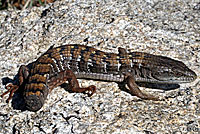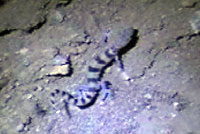Lizard Tail Loss and Regeneration


© 1990 FarWorks, Inc.

|
|||||||
Tail loss is also called "tail autotomy" or "caudal autotomy" or "tail-shedding." Many species of lizards are able to lose part of their tail to help them escape from a predator. The broken part of the tail falls to the ground where it continues to wriggle like a living creature, distracting the predator away from the lizard's vulnerable body, sometimes for as long as five minutes. This distraction allows the lizard to escape while the predator is left holding or trying to catch the detached tail. Since lizard tails are often used to store fat, they will provide some energy to a predator that eats it, and this might help the lizard by keeping the predator from searching for it again. Some lizards, such as skinks, are also known to eat their own severed tails for the energy stored in them. Some lizard species can voluntarily lose their tails even if little external force has been applied to the tail. They accomplish this by contracting muscles at the base of the tail which break the vertebra. But often the tail loss is the result of a predator grasping the tail and breaking it. Sometimes a lizard will thrash around a damaged or partly-broken tail until it breaks off completely. It's hard to know if a lizard is intentionally trying to detach its tail, but it often appears so. Losing the tail does not seriously harm a lizard, and may save its life, but the loss of a tail might have some negative effects besides a loss of stored energy. it could impair the lizard's ability to run quickly or balance itself while climbing, and a male lizard's attractiveness to the opposite sex might diminish along with its social standing. Tail loss in juveniles can also delay growth and sexual maturity. Broken tails do grow back, but these regenerated tails are often not as long as the original. Regenerated tails are made of cartilage instead of bone, but they can also be broken off. It is not uncommon to find lizards in the wild with no tail or with a partially regenerated tail, so tail autotomy apparently works. The tail of a juvenile skink is usually bright blue or bright pink. This helps the tail to be more visible to predators which lets the lizard use its tail loss defense. But the bright color on the tail often disappears when a juvenile becomes an adult. This is because adult females need the extra energy stored in the tail for the production of eggs or young, and adult males need the energy to court females and fight off other males. The needs of reproduction become more important to adults than the extra survival benefits of the tail loss defense. None of the detached tails shown below were broken off intentionally. They were all either intentionally released by a lizard that was stressed by capture or they were accidents of handling when the lizard's tail was pushed against a hard surface and it broke off, either intentionally or not. This should serve as a reminder that damage that can be done to a stressed lizard, even during careful handling, and a warning to always be careful of the tail when handling a lizard. (Much of this information comes from this book: Eric Pianka and Laurie J. Vitt. Lizards: windows to the evolution of diversity. University of California Press, 2003. |
|||||||
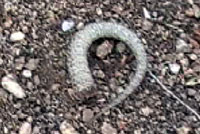 |
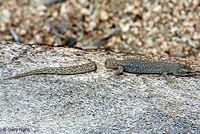 |
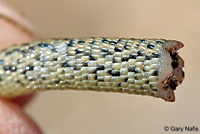 |
|||||
| This short video shows the detached tail of a Desert Night Lizard as it wriggles on the ground. (Everything is shown at normal speed. The video has been edited to show the wriggling tail as it slows down over about 4 minutes.) |
This adult Desert Night Lizard detached its tail as a defensive measure. (You can see the tail wriggling after it was detached in the video to the left.) |
This Southern Alligator Lizard was found missing most of tail | |||||
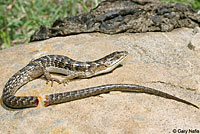 |
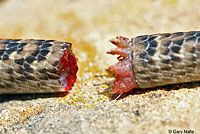 |
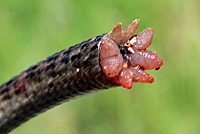 |
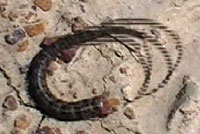 |
||||
| As we were photographing a Southern Alligator Lizard, my herping companion picked it up to get a better pose. The lizard had already been handled for 5 to 10 minutes and seemed to tolerate it, but this time it dropped its tail, apparently intentionally, though it might have been accidentally broken. We felt terrible to be responsible for the loss of such a nice unbroken tail. Sometimes when you pick up a lizard too close to the tail, or push the tail against a hard surface, you can accidentally cause it to detach, but that wasn't the case here. I put the writhing tail on the ground where it danced around for about 4 minutes until it stopped, shooting some video of it, then set it back next to the lizard to get these photos.The lizard was then put back under his log unharmed, but unable now to use a detached tail as a decoy until it grows another one. | This short video shows a Southern Alligator Lizard tail, detached from the body as it thrashes around wildly on the ground. This is the same tail shown in the picture to the left. | ||||||
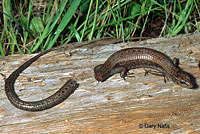 |
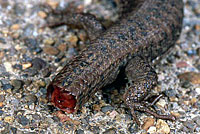 |
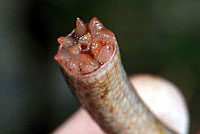 |
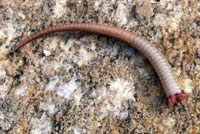 |
||||
| A Northern Alligator Lizard with a freshly detached tail. |
This short video shows what happened after a Western Red-tailed Skink dropped its tail to distract me from trying to catch it. The trick worked - I ignored the skink and filmed the tail and its writhing distracting motion. | ||||||
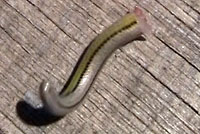 |
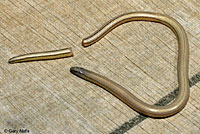 |
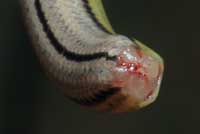 |
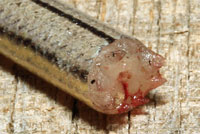 |
||||
| In this short video, the detached tail of a San Diegan Legless Lizard wriggles rapidly, looking like a living creature, until it gradually slows down. This illustrates how a lizard can detach its tail to distract a predator then crawl away to safety while the predator chases the tail. The lizard and tail parts are seen to the right. |
Adult San Diegan Legless Lizard with a detached tail. This tail was not removed intentionally, it was intentionally detached by the lizard by pushing it against a hard surface when it was stressed from being handled. |
Left: The body end of the detached tail |
|||||
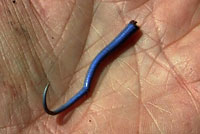 |
 |
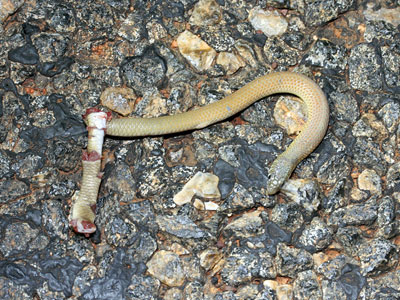 |
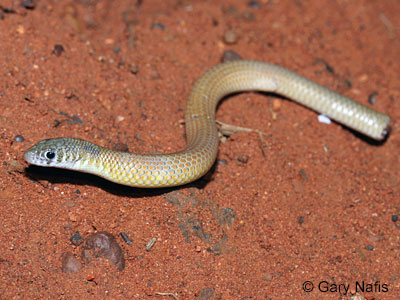 |
||||
| In this short video, a juvenile Northwestern Skink loses its blue tail, which writhes around on the ground. This is a defensive measure used to distract the predator which caused the tail to become detached from the rest of the lizard as it tries to escape. |
This Ground Skink lost its tail to a house cat, but survived. | This Australian Un-banded Delma, a legless lizard, was found trapped, stuck to a highway at night after its tail had been crushed by a passing vehicle and mashed into the tarmac. Fortunately, the tail can be detached without harming the lizard, so this one survived and crawled away after we separated it from the damaged part of its tail. |
|||||
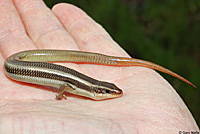 |
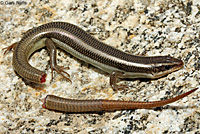 |
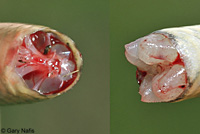 |
 |
||||
| Sub-adult Western Red-tailed Skink with tail, and after dropping its tail. | Tail parts of the skink seen to the left shortly after the tail was released - Left: the part attached to the lizard Right: the part that was dropped |
This short video shows the detached tail of a Desert Banded Gecko wriggling rapidly in a defensive measure used to distract a potential predator to chase the tail and not the lizard's more vital head and body. The lizard was found on a highway after it was recently killed by a vehicle. The tail was partly severed and wriggling. When the tail was completely detached from the body, it continued wriggling as it was blown across the asphalt by a strong wind. Once the wriggling started winding down the tail was put into an automobile to keep it out of the wind as it slowly stopped moving. The video has been edited down from about 6 minutes. | |||||
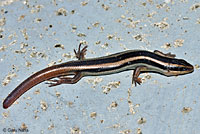 |
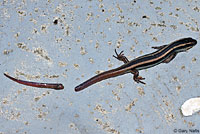 |
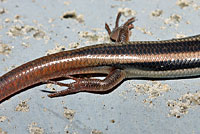 |
|||||
| Sub-adult Western Red-tailed Skink Kern County with a tail that broke off due to stress from handling. | |||||||
Tail Loss From Male Combat |
|||||||
 |
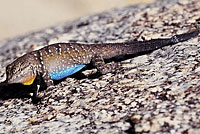 |
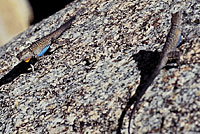 |
|||||
| Two male Northwestern Skinks in the breeding season apparently fighting over a female hiding nearby. One skink is biting the tail of the other skink. Male combat is another source of tail loss in lizards. © Cliff Peebles |
Adult male Small-scaled Lizards in combat in San Diego County, showing off their bright throat and ventral colors as a warning to the other male. These lizards were observed running around on top of a large boulder above a palm oasis, chasing and biting each other's tails and paying little attention to the photographer. Bite marks are visible on the tail of the lizard on the left. | ||||||
Using the Tail as a Distraction |
|||||||
Sometimes the color and pattern on the tail of a lizard is designed to make the tail more visible than the body of the lizard. This can distract a predator making it go after the tail, which is more expendable than the body. |
|||||||
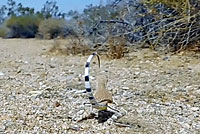 |
 |
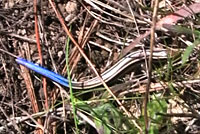 |
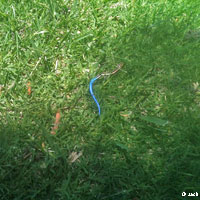 |
||||
| When running, Western Zebra-tailed Lizards raise up and wave their tail to show the zebra-like black and white bars on the bottom of the tail. This draws the predator's attention to the more expendable tail and away from the vulnerable body. | This Texas Greater Earless Lizard waves its barred tail to show its underside in order to distract a pursuer. It it is grabbed by a predator, the tail is less vulnerable than the rest of the body. | In this short video you can see how the blue tail on a juvenile Northwestern Skink stands out when the lizard moves, especially when it uses its stripes to blend into the vegetation. A predator is more likely to go for the tail, which can detach without hurting the lizard. | Adult Coronado Skink, San Diego County © Jack You can see in this distant shot how much the blue tail on a skink stands out. The light stripes and dark background on the head and body tend to blend into the background making them less noticeable. When a skink with a blue tail is running, it can look like there is a small bright blue snake wriggling instead of a lizard. That will attract the eye of a predator. But unlike the body, the tail is expendable. If a predator grabs it, it will come off easily but it will still move as if it is alive to distract the predator while the rest of the lizard gets away unharmed. |
||||
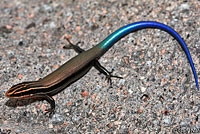 |
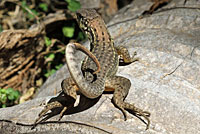 |
 |
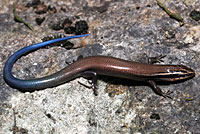 |
||||
| Adult Mountain Skink, Arizona | The Northern Curlytail Lizard curls its tail as a distraction. |
Juvenile Southeastern Five-lined Skink | Juvenile Long-lined Skink | ||||
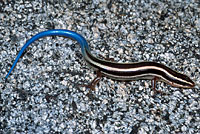 |
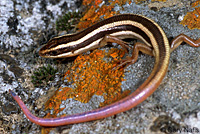 |
 |
|||||
| Juvenile Greater Brown Skink | Juvenile Western Red-tailed Skink | Juvenile NorthwesternNorthwestern Skink | This short video shot at night shows a Desert Banded Gecko crawling slowly and waving its tail as a distraction. | ||||
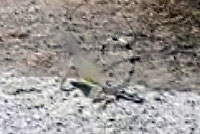 |
|||||||
| This short video shows several views of Western Zebra-tailed Lizards waving their striped tails to divert attention away from their main body, running off quickly, and doing the territorial push-up display. | |||||||
Tail Regeneration |
|||||||
| After the tail is broken off, either on purpose to distract a predator or by accident in a fight with another lizard, or a close call with a predator, it grows back or regenerates. Many lizards show evidence of tail regeneration. Sometimes it's the entire tail, sometimes just the tip. |
|||||||
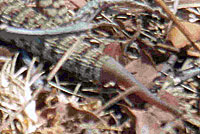 |
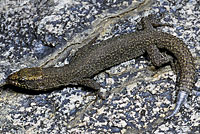 |
 |
 |
||||
| This Cape Giant Whiptail has a partially-regenerated tail. © Mauricio Correa | A Sierra Night Lizard with a partially regenerated tail. | A Texas Banded Gecko with a partially regenerated tail. | Western Zebra-tailed Lizard regenerating the end of her tail. | ||||
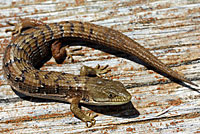 |
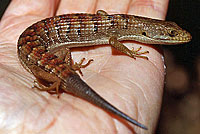 |
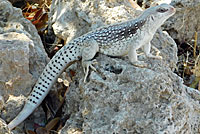 |
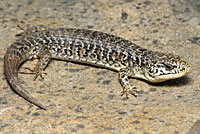 |
||||
| These Southern Alligator Lizards both have partially-regenerated tails | This Northern Desert Iguana has regenerated the end of its tail. | A San Francisco Alligator Lizard with a partially-regenerated tail. | |||||
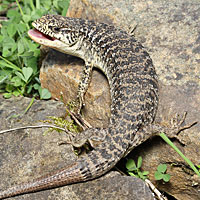 |
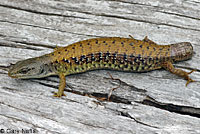 |
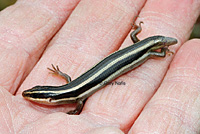 |
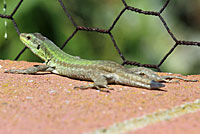 |
||||
| A San Francisco Alligator Lizard with a partially-regenerated tail. | This Shasta Alligator Lizard has a recently-severed tail that has not yet regenerated. | Juvenile Western Red-tailed Skink with regenerating tail. | Italian Wall Lizard with a regenerating tail. |
||||
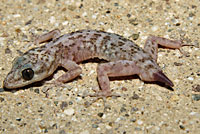 |
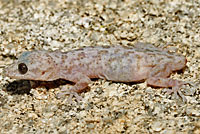 |
 |
 |
||||
| Peninsular Leaf-toed Gecko with re-generating tail | Peninsular Leaf-toed Gecko with recently severed tail. | Common Chuckwalla with a regenerated tail. |
Juvenile Island Fence Lizard with re-growing tail. |
||||
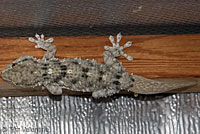 |
 |
 |
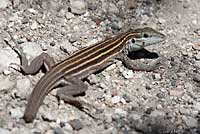 |
||||
| Moorish Gecko with regenerated tail © Tim Valentine |
When they fight, male lizards often bite the other lizard's tail. Bite marks are visible on the tail of the Small-scaled Lizard on the left. | It's not common to see whiptails with missing tails, but this Plateau Striped Whiptail lost most of its tail. | |||||
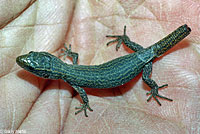 |
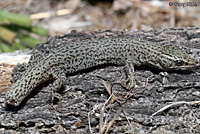 |
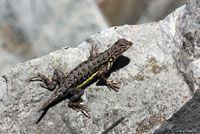 |
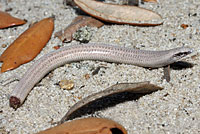 |
||||
| Juvenile Desert Night Lizard with severed tail. |
Adult Desert Night Lizard with severed tail. |
Sonoran Earless Lizard regenerating its tail. |
Florida Sand Skink with recently severed tail. |
||||
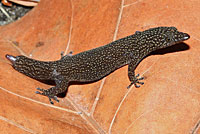 |
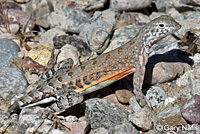 |
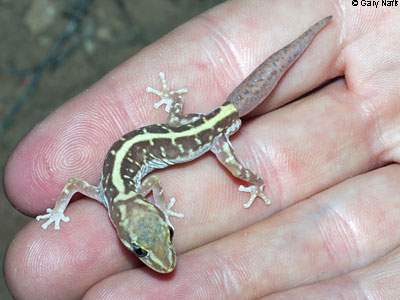 |
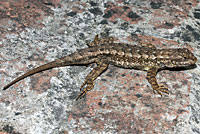 |
||||
| Ashy Gecko with regenerating tail. | Chihuahuan Greater Earless Lizard with regenerating tail. |
When Geckos regenerate their tail, as this Australian Pale-striped Ground Gecko has done, it often does not match the body's color and pattern as did the original tail. | This Coast Range Fence Lizard appears to have regenerated much of its tail. | ||||
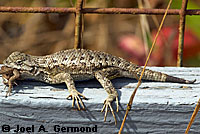 |
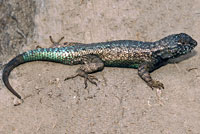 |
 |
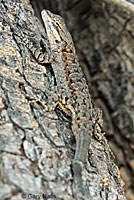 |
||||
| This Coast Range Fence Lizard has regenerated part of its tail. © Joel A. Germond |
Adult Island Fence Lizard with a regrown tail. |
Juvenile Island Fence Lizard re-growing its tail. |
This Colorado River Tree Lizard has a regenerating tail. | ||||
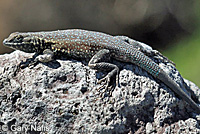 |
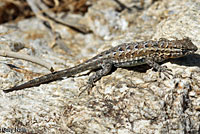 |
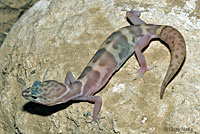 |
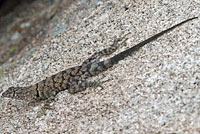 |
||||
| This Western Side-blotched Lizard has regrown much of his tail. | This Western Side-blotched Lizard has regrown the end of her tail. | You can see by the color and pattern difference between the tail and the body that this Desert Banded Gecko has regrown most of its tail. | This Mearns' Rock Lizard has regrown most of its tail. Once banded, the new tail is now black. |
||||
Unusual Tail Regeneration including Bifurcated or Forked Tails |
|||||||
Sometimes after a tail is broken off, two tails grow back from the break point. |
|||||||
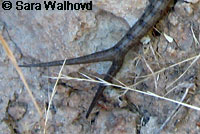 |
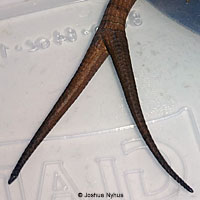 |
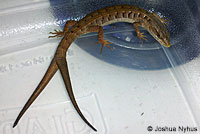 |
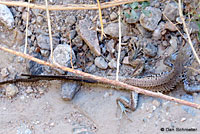 |
||||
| Adult Southern Alligator Lizard, Placer County, with a forked regenerated tail. © Sara Walhovd |
Adult Southern Alligator Lizard, Los Angeles County with a large forked tail. © Joshua Nyhus |
This Great Basin Whiptail from Riverside County has an abnormal forked tail, probably resulting from an injury. © Dan Schroeter |
|||||
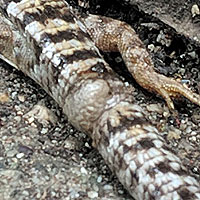 |
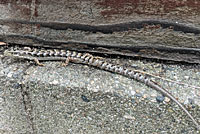 |
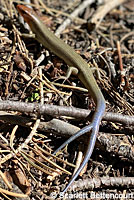 |
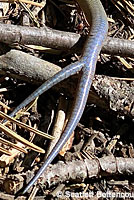 |
||||
| Adult Southern Alligator Lizard. This lizard apparently suffered an injury to its tail (which was partly regenerated already), but the tail did not break off at the point of injury. The injury healed irregularly as you can see here. | This adult male Greater Brown Skink with breeding colors on his head was found in late May at approx. 5,600 ft. elevation (1,077 m.) in the Sierra Nevada Mountains in Tuolumne County. Note that the tail has grown a second branch, probably from the site of an injury that did not break off the entire tail. © Scarlett Bettencourt | ||||||
 |
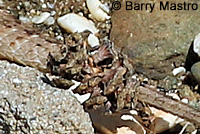 |
||||||
| Baja California Spiny Lizard, Baja California. © Barry Mastro According to the photographer, this lizard apparently suffered an injury to its tail that did not cause the tail to break off. Instead, parts of the tail grew back in the chaotic mess you see above. |
|||||||
Return to the Top
© 2000 -

